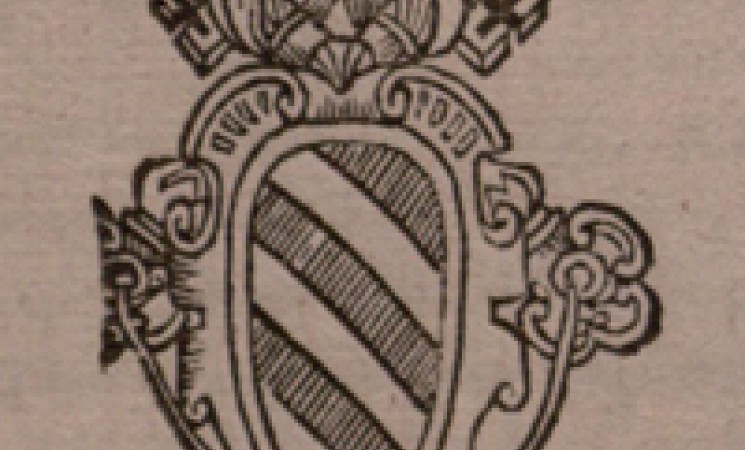A papal bull against bullfighting

One of our most interesting recent acquisitions is a papal bull against bullfighting: Bulla S.D. N. Pii Pape V. Super prohibitione agitationis Taurorum & Ferarum, & annulatione votorum & iuramentorum, super eisdem pro tempore interpositorum (Rome: heirs of Antonio Blado, 1567). Papal bulls are decrees issued by the Pope. This particular bull is considered one of the foundation documents of the animal protection movement.
A Yale Law School LL.M. student, Raffael Nicolas Fasel, saw the bull on a tour of the Rare Book Collection and offered to write about it. I am pleased to welcome Raffael as a guest blogger. His piece fits well with the Christmas spirit. – MIKE WIDENER, Rare Book Librarian
De Salute Gregis Dominici: A Papal Bull Banning Bullfighting in 1567
by Raffael Nicolas Fasel
LL.M. candidate, Yale Law School
Although the spectacles of the Roman Colosseum and other staged fights between human and non-human animals are long past, bullfighting persists in some parts of the modern world. Today, the so-called corridas de toros are being held not only in Spain, Portugal and Southern France, but also in Latin American countries such as Mexico, Colombia, Ecuador, Venezuela and Peru.
It is estimated that each year approximately 10,000 bulls are killed in these fights. Because of the torment that is caused to the animals – predominantly bulls, but also the horses used by lancers who stab the bulls – many regard bullfighting as an archaic and barbaric tradition.
For this reason, numerous countries have adopted prohibitions on bullfighting. In these countries, the practice is either forbidden by a specific ban – as in the case of the Catalan bullfighting ban from 2012 – or by a more general anti-cruelty statute.
However, banning bullfighting is not as recent a phenomenon as one would think. Already half a millennium before Catalonia’s ban, the Catholic Church adopted an interdiction of bullfighting and similar types of blood sports that involve animals. In 1567 the pope, St. Pius V, issued a papal bull titled Super prohibitione agitationis Taurorum & Ferarum (“An injunction forbidding bullfights and similar sports with wild animals”), and commonly referred to as “De Salute Gregis Dominici” (“On the welfare of the Lord’s flock”). The bull is one of the treasures in the Rare Book Collection of the Yale Law Library.
In his bull, Pope Pius V “removed from Christian piety and charity” any spectacles “in which bulls and other wild animals are challenged in circuses and plazas.” Under penalty of excommunication, the bull forbade staging and attending fights in which men confronted bulls or other wild animals. Bullfights and similar events are denounced by the bull as constituting “cruel and base spectacles of the devil and not of man.”
In the legal system of the Catholic Church, the 1567 bull has lost some of its importance because later popes, Gregory XIII and Clement VIII, limited the ban on attending bullfights to members of the clergy and to spectacles taking place on religious holidays. However, Pius V’s bull has never been directly repealed by another bull or provision of canon law. Like all other papal bulls, the 1567 bull has been endowed with perpetual validity in accordance with the formula “ad perpetuam rei memoriam” (“for a permanent record of the matter”), which is stated in its very beginning. Therefore, to the extent that the bull has not been overridden by any subsequent provisions, it remains in force.
In comparison with modern-day animal protection laws, the 1567 bull adheres to what is nowadays seen as an outdated anthropocentric model of animal protection. Pope Pius V was not so much concerned with the well-being of the animals themselves, but rather with the salvation and the welfare of the Lord’s flock, that is, the Christians. It was not until the 19th century that animal protection statutes were adopted for the animals’ own sakes.
As a precursor of these more modern and secular prohibitions of bullfighting, however, pope Pius V’s “De Salute Gregis Dominici” bull remains an important point of reference.
A digitized version of the 1567 Super prohibitione agitationis Taurorum & Ferarum is available here, in Internet Culturale, the web portal to digital collections in Italian libraries.
A partial English translation of the bull is provided on the website of SHARK (SHowing Animals Respect and Kindness).
People for the Ethical Treatment of Animals (PETA) has a discussion of Pius V’s bull on its website; for an alternate view, see “The Morality of the Bullfight” on the Saint Louis Catholic blog.

